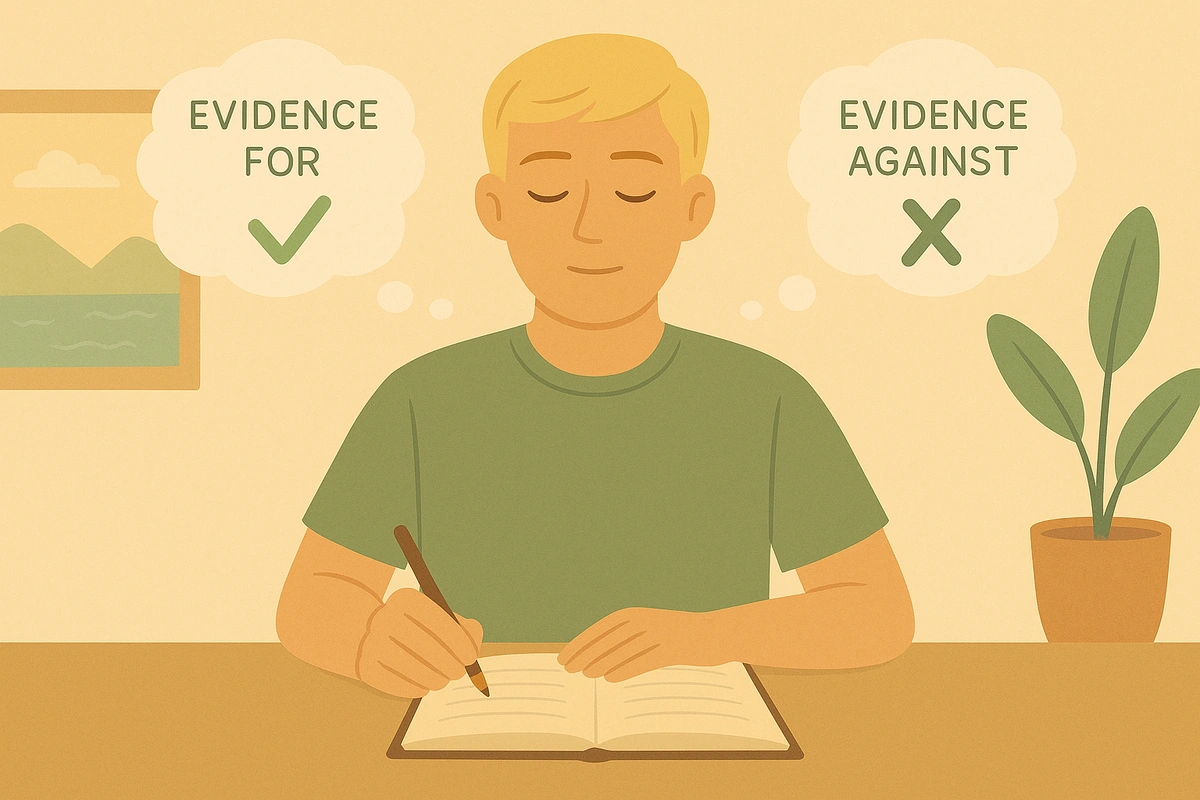The Evidence For vs. Against Thought technique is a powerful cognitive tool that helps you step back from anxious or distressing thoughts and evaluate them like a detective examining evidence, leading to more balanced, realistic thinking and reduced emotional distress.

Your mind is constantly interpreting events and making predictions about what might happen, but sometimes these interpretations become distorted by anxiety, depression, or stress. Think of your anxious thoughts like witnesses in a courtroom - they might seem very convincing at first, but they could be unreliable or biased. The Evidence For vs. Against technique helps you become the judge in your own mental courtroom, carefully examining the facts before reaching a verdict.
When you're caught in the grip of a distressing thought like "I'm going to embarrass myself" or "Something terrible will happen," your emotional brain takes over and the thought feels absolutely true. But feelings aren't facts, and this technique teaches you to activate your logical brain to examine whether your thoughts are based on solid evidence or just fear and assumptions. By systematically looking at both sides of the story, you can develop more accurate, balanced perspectives that reduce anxiety and help you make better decisions based on reality rather than worry.
The Evidence For vs. Against technique works by engaging your brain's natural capacity for logical analysis and critical thinking, helping you step out of emotional reasoning and into objective evaluation. When you're anxious or depressed, your mind tends to focus selectively on information that confirms your fears while ignoring contradictory evidence - a cognitive bias called confirmation bias.
This structured approach forces you to examine both sides of your mental argument, similar to how a good lawyer examines all available evidence before making a case. Research in cognitive behavioral therapy shows that this type of systematic thought evaluation activates your prefrontal cortex - the brain region responsible for logical reasoning and executive decision-making.
The technique works because it interrupts automatic negative thinking patterns and replaces them with deliberate, conscious evaluation. Instead of accepting distressing thoughts at face value, you learn to treat them as hypotheses that need testing. This shift from passive acceptance to active investigation fundamentally changes your relationship with anxious or depressive thoughts.
Studies demonstrate that cognitive restructuring techniques like evidence evaluation can reduce anxiety and depression symptoms by helping people develop more accurate and balanced thinking patterns. The process teaches your brain to default to evidence-based reasoning rather than emotion-based assumptions.
The effectiveness also comes from the written format, which engages multiple learning pathways and creates a concrete record you can refer to later. Research confirms that thought records are highly successful at creating belief change and helping people develop more realistic perspectives on challenging situations.
Additionally, the technique provides a sense of control and agency over your mental experience. Instead of feeling victimized by anxious thoughts, you become an active investigator who can evaluate and modify distressing thinking patterns, building confidence in your ability to manage emotional challenges.
"I can only find evidence that supports my anxious thought" - This often indicates you're mixing facts with interpretations or focusing on possibilities rather than probabilities. Try asking trusted others for their perspective, or look specifically for times when similar worries didn't materialize. Sometimes the absence of supporting evidence is itself important evidence against the thought.
"The evidence against my thought doesn't feel convincing even though I know it's logical" - Emotions often lag behind logical understanding. Continue practicing the technique regularly, and consider adding behavioral experiments to test your balanced thoughts in real-world situations. Feelings typically catch up with logical insights over time.
"I keep finding new 'what if' scenarios that support my worry" - This suggests you're engaging in hypothetical thinking rather than evidence-based analysis. Focus only on actual past experiences and current facts, not imagined future possibilities. Ask yourself: "Has this actually happened before, or am I inventing scenarios?"
"My negative thought feels so true that I can't even consider contradicting evidence" - Start with less emotionally charged thoughts to build the skill, or try the technique when you're feeling calmer. Sometimes writing down the thought exactly as it appears in your mind helps create enough distance to examine it more objectively.
"I complete the analysis but the anxious thought comes back immediately" - This is normal, especially when working with deeply ingrained thought patterns. Keep your written analysis handy to review when the thought returns, and be patient with the process. Repeated practice gradually weakens automatic negative thinking patterns.
"I feel like I'm just trying to talk myself out of realistic concerns" - Good evidence analysis should acknowledge legitimate concerns while putting them in proper perspective. If your evaluation reveals genuine problems, use that information to make appropriate plans rather than dismissing real issues.
"The technique feels too intellectual and doesn't help with the emotional intensity" - Combine evidence analysis with emotion regulation techniques like deep breathing or grounding exercises. Also, consider working with a therapist who can help you process the emotional aspects of distressing thoughts alongside the cognitive analysis.
"I can't concentrate well enough to complete the analysis when I'm really anxious" - Practice during calmer moments to build the skill, and consider simplifying the technique during high-anxiety periods. Even a brief, informal mental review of evidence can be helpful when detailed written analysis isn't feasible.